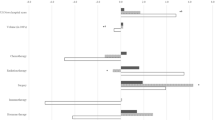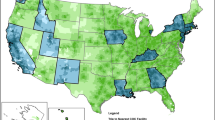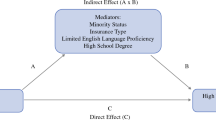Abstract
Delayed treatment and non-adherence are associated with inferior prostate cancer (CaP) outcomes. Missed clinic appointments (MA) are one form of non-adherence that may be preventable. We conducted a retrospective cohort study of 1341 scheduled clinic encounters for men referred to an academic urology clinic for evaluation of known or suspected CaP. Driving distance and public transit times were calculated using a Google Distance Matrix API algorithm. Zip code level data regarding socioeconomic status was obtained from the 2013 American Community Survey. Logistic regression multivariate analysis was used to identify MA predictors. Of scheduled clinic encounters, 14% were missed. Public health insurance was associated with MA (Private insurance 10%, Public insurance 19%), (p < 0.01) Calendar month was associated with MA with December showing the highest rate (21.2%) and June the lowest (5.3%) rates. (p = 0.02) Appointments for suspected CaP were more likely to be missed (19.3%) than those for known CaP (10.5%), p < 0.01. Driving distance was inversely associated with rate of MA (CA median 11.8 miles, MA median 10.4 miles, p = 0.04) while public transit times were not (66.7 min for CA, 65.3 min for MA, p = 0.36). Men that missed appointments were from areas with lower household incomes and educational attainment. Patient encounter type, insurance status, and reason for referral remained significantly associated with MA after multivariable adjusted analysis. By computing public transit time to the clinic using a mapping engine, we present a novel way to measure this parameter for studies of urban health care.


Similar content being viewed by others
References
Siegel, R. L., Miller, K. D., & Jemal, A. (2016). Cancer statistics, 2016. CA: A Cancer Journal for Clinicians, 66(1), 7–30.
Eggener, S. E., Scardino, P. T., Walsh, P. C., et al. (2011). Predicting 15-year prostate cancer specific mortality after radical prostatectomy. The Journal of Urology, 185(3), 869–875.
Johansson, J. E., Andren, O., Andersson, S. O., et al. (2004). Natural history of early, localized prostate cancer. JAMA, 291(22), 2713–2719.
Abern, M. R., Aronson, W. J., Terris, M. K., et al. (2013). Delayed radical prostatectomy for intermediate-risk prostate cancer is associated with biochemical recurrence: Possible implications for active surveillance from the SEARCH database. The Prostate, 73(4), 409–417.
Luckett, R., Pena, N., Vitonis, A., Bernstein, M. R., & Feldman, S. (2015). Effect of patient navigator program on no-show rates at an academic referral colposcopy clinic. Journal of Women’s Health (2002), 24(7), 608–615.
Garuda, S. R., Javalgi, R. G., & Talluri, V. S. (1998). Tackling no-show behavior: A market-driven approach. Health Marketing Quarterly, 15(4), 25–44.
Izard, T. (2005). Managing the habitual no-show patient. Family Practice Management, 12(2), 65–66.
2009–2013 American Community Survey 5 Year Estimates: American Fact Finder2013 Contract No.: November 1, 2015.
Hashim, M. J., Franks, P., & Fiscella, K. (2001). Effectiveness of telephone reminders in improving rate of appointments kept at an outpatient clinic: A randomized controlled trial. The Journal of the American Board of Family Practice/American Board of Family Practice, 14(3), 193–196.
Parikh, A., Gupta, K., Wilson, A. C., Fields, K., Cosgrove, N. M., & Kostis, J. B. (2010). The effectiveness of outpatient appointment reminder systems in reducing no-show rates. The American Journal of Medicine, 123(6), 542–548.
Syed, S. T., Gerber, B. S., & Sharp, L. K. (2013). Traveling towards disease: Transportation barriers to health care access. Journal of Community Health, 38(5), 976–993.
Lacy, N. L., Paulman, A., Reuter, M. D., & Lovejoy, B. (2004). Why we don’t come: Patient perceptions on no-shows. Annals of Family Medicine, 2(6), 541–545.
Freeman, V. L., Ricardo, A. C., Campbell, R. T., Barrett, R. E., & Warnecke, R. B. (2011). Association of census tract-level socioeconomic status with disparities in prostate cancer-specific survival. Cancer Epidemiology, Biomarkers & Prevention, 20(10), 2150–2159.
Keegan, K. A., & Penson, D. F. (2013). The Patient Protection and Affordable Care Act: The impact on urologic cancer care. Urologic Oncology, 31(7), 980–984.
Ward, E., Jemal, A., Cokkinides, V., et al. (2004). Cancer disparities by race/ethnicity and socioeconomic status. CA: A Cancer Journal for Clinicians, 54(2), 78–93.
Mahal, B. A., Aizer, A. A., Ziehr, D. R., et al. (2014). The association between insurance status and prostate cancer outcomes: Implications for the Affordable Care Act. Prostate Cancer and Prostatic Diseases, 17(3), 273–279.
Fossati, N., Nguyen, D. P., Trinh, Q. D., et al. (2015). The impact of insurance status on tumor characteristics and treatment selection in contemporary patients with prostate cancer. Journal of the National Comprehensive Cancer Network: JNCCN, 13(11), 1351–1358.
Casey, R. G., Quinlan, M. R., Flynn, R., Grainger, R., McDermott, T. E., & Thornhill, J. A. (2007). Urology out-patient non-attenders: Are we wasting our time? Irish Journal of Medical Science, 176(4), 305–308.
Arcury, T. A., Preisser, J. S., Gesler, W. M., & Powers, J. M. (2005). Access to transportation and health care utilization in a rural region. The Journal of Rural Health, 21(1), 31–38.
Yang, S., Zarr, R. L., Kass-Hout, T. A., Kourosh, A., & Kelly, N. R. (2006). Transportation barriers to accessing health care for urban children. Journal of Health Care for the Poor and Underserved, 17(4), 928–943.
Silver, D., Blustein, J., & Weitzman, B. C. (2012). Transportation to clinic: findings from a pilot clinic-based survey of low-income suburbanites. Journal of Immigrant and Minority Health/Center for Minority Public Health, 14(2), 350–355.
Simon, M. A., Nonzee, N. J., McKoy, J. M., et al. (2013). Navigating veterans with an abnormal prostate cancer screening test: A quasi-experimental study. BMC Health Services Research, 13, 314.
Dobbs, R. W., Greenwald, D. T., Wadhwa, H., Freeman, V. L., & Abern, M. R. (2017). Is prostate cancer stage migration continuing for black men in the PSA era?. Prostate Cancer Prostatic Diseases, 20(2), 210–215
Molfenter, T. (2013). Reducing appointment no-shows: Going from theory to practice. Substance Use and Misuse, 48(9), 743–749.
Aarts, M. J., Koldewijn, E. L., Poortmans, P. M., Coebergh, J. W., & Louwman, M. (2013). The impact of socioeconomic status on prostate cancer treatment and survival in the southern Netherlands. Urology, 81(3), 593–599.
Shafique, K., & Morrison, D. S. (2013). Socio-economic inequalities in survival of patients with prostate cancer: Role of age and Gleason grade at diagnosis. PLoS ONE, 8(2), e56184.
Chu, D. I., Moreira, D. M., Gerber, L., et al. (2012). Effect of race and socioeconomic status on surgical margins and biochemical outcomes in an equal-access health care setting: Results from the Shared Equal Access Regional Cancer Hospital (SEARCH) database. Cancer, 118(20), 4999–5007.
Chariatte, V., Michaud, P. A., Berchtold, A., Akre, C., & Suris, J. C. (2007). Missed appointments in an adolescent outpatient clinic: Descriptive analyses of consultations over 8 years. Swiss Medical Weekly, 137(47–48), 677–681.
Frankel, S., Farrow, A., & West, R. (1989). Non-attendance or non-invitation? A case-control study of failed outpatient appointments. BMJ, 298(6684), 1343–1345.
Lamplugh, M., Gilmore, P., Quinlan, T., & Cornford, P. (2006). PSA testing: Are patients aware of what lies ahead? Annals of the Royal College of Surgeons of England, 88(3), 284–288.
Okoro, C. A., Strine, T. W., Young, S. L., Balluz, L. S., & Mokdad, A. H. (2005). Access to health care among older adults and receipt of preventive services. Results from the Behavioral Risk Factor Surveillance System, 2002. Preventive Medicine, 40(3), 337–343.
Guidry, J. J., Aday, L. A., Zhang, D., & Winn, R. J. (1997). Transportation as a barrier to cancer treatment. Cancer Practice, 5(6), 361–366.
Wardenburg, M. J., Dobbs, R. W., Barnes, G., Al-Qassab, U., Ritenour, C. W., & Issa, M. M. (2013). Elective versus routine postoperative clinic appointments after circumcisions performed under local anesthesia. Urology, 81(6), 1135–1140.
Syed, S. T., Sharp, L. K., Kim, Y., et al. (2016). Relationship between medication adherence and distance to dispensing pharmacies and prescribers among an urban medicaid population with diabetes mellitus. Pharmacotherapy, 36(6), 590–597.
Salloum, R. G., Smith, T. J., Jensen, G. A., & Lafata, J. E. (2012). Factors associated with adherence to chemotherapy guidelines in patients with non-small cell lung cancer. Lung Cancer, 75(2), 255–260.
Author information
Authors and Affiliations
Corresponding author
Ethics declarations
Conflict of interest
The authors declare that they have no conflict of interest.
Rights and permissions
About this article
Cite this article
Dobbs, R.W., Malhotra, N.R., Caldwell, B.M. et al. Determinants of Clinic Absenteeism: A Novel Method of Examining Distance from Clinic and Transportation. J Community Health 43, 19–26 (2018). https://doi.org/10.1007/s10900-017-0382-z
Published:
Issue Date:
DOI: https://doi.org/10.1007/s10900-017-0382-z




